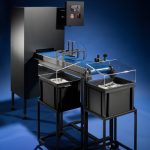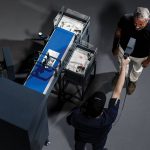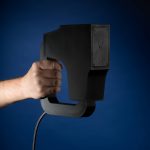AI Facial Profiling, Levels of Paranoia by Marta Revuelta, in collaboration with Laurent Weingart, software development and Marc Wettstein, mechatronic system.
A project that explores the disturbing uses of automatic processes of human being binary classification controlled by artificial intelligence by proposing a “thinking machine”, an AI-driven profiling system that recognizes the ability of an individual to handle firearms and predicts his potential danger from a biometric analysis of his face. The device is made up of a weapon-camera that captures the faces of the visitors, and machine learning algorithms that classifies them into two typologies. It also includes a mechanical system that generates intelligence cards with profiled people’s photography. This physiognomic machine is directly inspired by industrial systems and proposes a staging inspired by security infrastructures taking the individual as the starting point for a critical reflection about algorithmic biases and the bipolarization of human labelling; a narrative that explores the ethical limits of these AI driven artefacts and refers to the legitimisation of their empowering decision-making.
Marta Revuelta is an artist and designer who lives and works in Geneva. Fascinated by the mutations of technological innovations and algorithmic governmentality, or how algorithms play an important role in ethical, political and legal issues, her work explores the moments of drift or perversion of technology, its misuses and its infrastructures. Her current projects associate scientific researches, essentially in the field of artificial intelligence, to art installations and seek to reveal and share scientific results integrating algorithms of machine learning and computer vision into mechatronic constructions. Through her work she questions the ethical limits and the status of these technological artifacts driven by AI and she tries to make algorithmic systems, characterized by their total opacity, more tangible and perceptible, to reveal their mechanisms and explore their impacts, halfway between critical design and art, engineering and data science.




